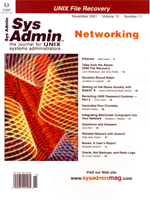 Books:
A User's Report Books:
A User's Report
Elizabeth Zinkann
My August column contained a review of the first edition of Networking:
A Beginner's Guide, which coincided with the release of
Networking: A Beginner's Guide, Second Edition. The
latest release modifies numerous topics and adds a very important
chapter on Disaster Recovery. I have included a review of the second
edition in this column, in addition to reviews of the new Perl Bookshelf
and a certification guidebook. The book titles, authors, and publishers
of this month's selections include: SAIR Linux/GNU Installation
and Configuration Exam Cram by Michael Jang (Coriolis); The
Perl CD Bookshelf; Version 2.0 (O'Reilly & Associates,
Inc.); and Networking: A Beginner's Guide, Second Edition
by Bruce Hallberg (Osborne McGraw-Hill).
SAIR Linux/GNU Installation and Configuration Exam Cram,
Michael Jang
The Coriolis Group
ISBN 1-57610-953-4
351 Pages
$34.99
Reference Card Included
http://www.coriolis.com/
http://www.examcram.com/
Certification acknowledges the achievement of a recognized level
of expertise, whether attained through study, experience, or a combination
of the two. In this Coriolis Exam Cram book, author Michael Jang
demonstrates the structures and procedures of the SAIR Linux/GNU
certification tests and examines the content of the Installation
and Configuration Level One Exam 3X0-101. The Introduction, Self-Assessment,
and Chapter 1 (Sair Linux/GNU Certification Exams) provide the reader
with fundamental information about the certification process, how
to prepare for the exam, the best way to use this book, and the
mechanics of the Sair Linux/GNU test administration. The author
also examines the subjects that this test includes.
In Chapters 2 through 14, Jang addresses the following topics:
A Short History of Linux, Linux Structure, Hardware Configuration,
Installation Options, Startup and Shutdown, Commanding the Shell,
Using the Shell, Managing Printers, The X Window, System Administration,
Network Configuration, Applications, and Troubleshooting. The concluding
chapters contain a Sample Test and Answer Key, and the Appendix
reprints the GNU General Public License followed by a detailed 23-page
Glossary and the Index.
As Jang presents each aspect of the test subjects, he explains
the underlying concept, outlines its implementation, and demonstrates
its use through numerous examples. The descriptions and explanations
are effectively discussed and clearly illustrated. This Exam Cram
book furnishes the reader with several aids and resources for certification
testing: a four-sided reference card, a specialized Web site (http://www.examcram.com),
an optional newsletter from http://www.coriolis.com, sample
questions and answers, and the author's tips and alerts, which
are highlighted throughout the book.
The beginning of the book helps the reader establish his or her
individual status, what to expect during the test, and how to prepare
for testing. The format of each chapter begins with "Terms
you'll need to understand" and "Techniques you'll
need to master", followed by a short introduction and chapter
overview. The chapters end with Practice Questions, thorough answers
that explain why each of the multiple choice answers is right or
wrong, and additional references. The Practice Questions and Answers
not only give the reader a feel for the exam, but also emphasize
the importance of carefully reading each question and answer. The
SAIR Linux/GNU Installation and Configuration Exam Cram by
Michael Jang is an informative and well-written guide to the Sair
Linux/GNU Installation and Configuration exam. It is an excellent
preparation tool and also a superb Linux reference.
The Perl CD Bookshelf
Version 2.0
O'Reilly & Associates, Inc.
ISBN 0-596-00164-9
$79.95
Book Included
http://www.oreilly.com
Most new revisions or editions contain modifications to reflect
changes in software or hardware. The latest release of The Perl
Bookshelf changed the book selections on the CD-ROM. The original
version included both the hard copy and the electronic versions
of Perl in a Nutshell, Programming Perl Second Edition,
the Perl Cookbook, Advanced Perl Programming, Learning
Perl Second Edition, and Learning Perl on Win32 Systems.
That selection addressed Perl Programmers, novices, systems administrators,
and users on several platforms and varied levels of expertise.
The new, improved release contains: hard copy and electronic versions
of Perl in a Nutshell (by Ellen Siever, Stephen Spainhour,
and Nathan Patwardhan, ISBN 1-56592-286-7, $29.95); Programming
Perl, Third Edition (by Larry Wall, Tom Christiansen, and Jon
Orwant, ISBN 0-596-00027-8, $49.95); the Perl Cookbook (by
Tom Christiansen and Nathan Torkington, ISBN 1-56592-243-3, $39.95);
Advanced Perl Programming (by Sriram Srinivasan, ISBN 1-56592-220-4,
$34.95); and Perl for System Administration (by David N.
Blank-Edelman, ISBN 1-56592-609-9, $34.95). This substitution effectively
transforms The Perl CD Bookshelf from a reference for all levels
to a resource and utility for Perl programmers and systems administrators.
The easily transportable CD-ROM can be used on any Web browser
software with Java Version 1.1.2 or later. Users can search through
any of the five books separately or all of them simultaneously,
either by using the Table of Contents to find the section and chapter
or by entering a search term. The user can then choose to read the
answer, the section in which the answer appears, the entire chapter,
or any cross-references that may apply. The Perl CD Bookshelf's
interface is easy to navigate and provides a quick method to finding
that elusive phrase or solution. It is an ideal way to access several
resources from a remote location without carrying ten pounds of
books to the site. The Perl CD Bookshelf is an excellent utility
for anyone who uses Perl.
Networking: A Beginner's Guide
Second Edition
Bruce Hallberg
Osborne McGraw-Hill
ISBN 0-07-213231-0
432 Pages
$39.99
http://www.osborne.com/
The fundamentals of network implementation and configuration have
become essential tools for computer professionals and hobbyists
alike. Whether you are a systems administrator, a programmer, a
certification student, or a user setting up a home network, you
utilize the same networking concepts and procedures. Hallberg's
second edition of Networking: A Beginner's Guide demonstrates
both the abstract principles and the practical techniques required
to design and establish a network. Three completely new chapters
stand out among the numerous modifications and additions within
the second edition: The Business of Networking, Laying the Foundation,
and Network Disaster Recovery.
The first of the new chapters, The Business of Networking, describes
a company network from a corporate viewpoint and defines some of
the network-related positions within the business framework and
their respective job descriptions. In Laying the Foundation, Hallberg
briefly explains the different numbering systems (binary, octal,
and hexadecimal) used in networking plus bandwidth terminology.
The most technically oriented of the recent additions is the Network
Disaster Recovery chapter. It analyzes Disaster Recovery Plans and
Network Backup and Restore contingencies; technical editor Tony
Ryan contributed a valuable section describing the Seattle 2001
earthquake and the recovery that followed it. The NetWare chapters
(Installing and Setting Up NetWare 5.1, Administering NetWare: The
Basics, and Understanding Other NetWare Services) have been revised.
NetWare 5.1 replaces the NetWare 5.0 procedures described in the
original version. Linux users will notice that Hallberg uses Red
Hat 7.0 and the accompanying figures display the 7.0 screens. (Red
Hat 7.1 processes basically remain the same, although some of the
GUI screens and menus differ.)
Hallberg's Networking: A Beginner's Guide, Second
Edition is an excellent selection for anyone interested or involved
with the design and configuration of a network. The author discusses
the essential components, policies, and plans for consideration,
and features unique to the most popular operating systems. The result
is an informative guide and reference for the experienced computer
user.
Elizabeth Zinkann has been involved in the UNIX and C environment
for the past 15 years. She is currently a UNIX and C consultant,
and one of her specialties is UNIX education. In addition to her
computer science background, she also has a degree in English. Her
writing has also appeared in Linux Magazine, Performance
Computing, and Network Administrator. Elizabeth can be
reached at: elizabeth@equillink.com.
|

